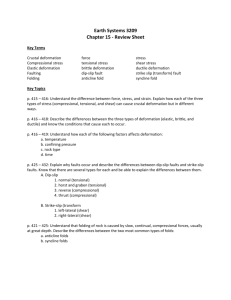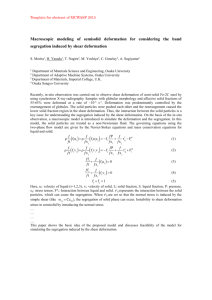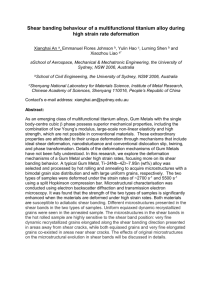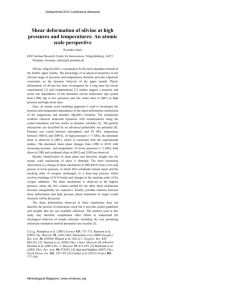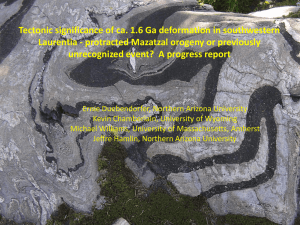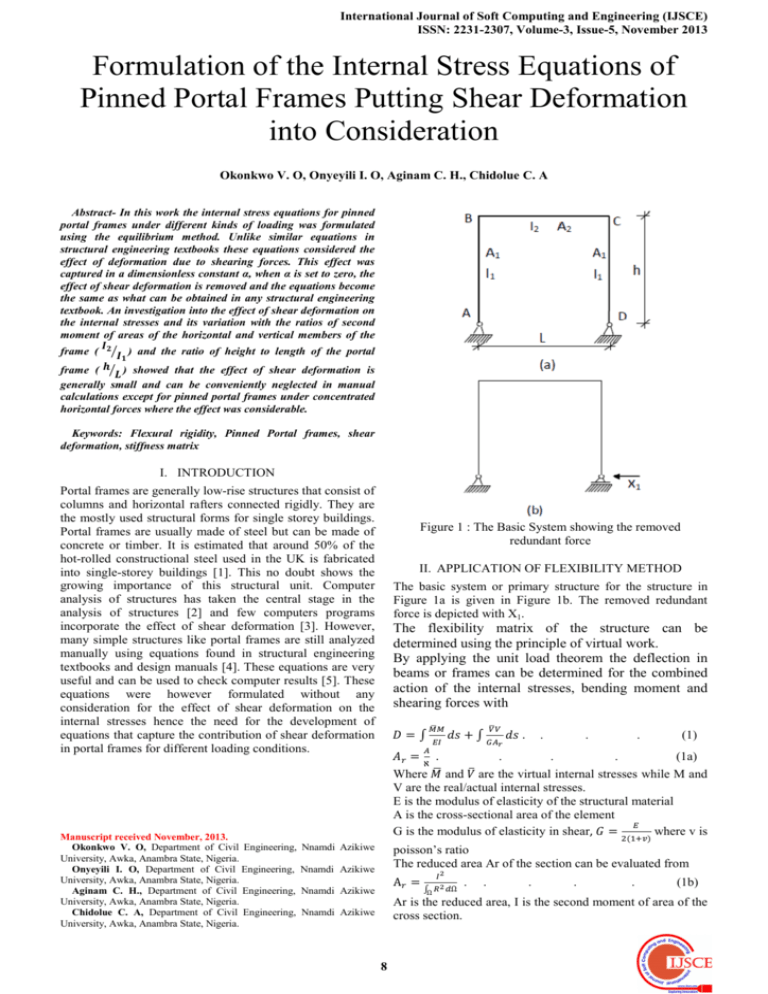
International Journal of Soft Computing and Engineering (IJSCE)
ISSN: 2231-2307, Volume-3, Issue-5, November 2013
Formulation of the Internal Stress Equations of
Pinned Portal Frames Putting Shear Deformation
into Consideration
Okonkwo V. O, Onyeyili I. O, Aginam C. H., Chidolue C. A
Abstract- In this work the internal stress equations for pinned
portal frames under different kinds of loading was formulated
using the equilibrium method. Unlike similar equations in
structural engineering textbooks these equations considered the
effect of deformation due to shearing forces. This effect was
captured in a dimensionless constant α, when α is set to zero, the
effect of shear deformation is removed and the equations become
the same as what can be obtained in any structural engineering
textbook. An investigation into the effect of shear deformation on
the internal stresses and its variation with the ratios of second
moment of areas of the horizontal and vertical members of the
frame (
) and the ratio of height to length of the portal
frame (
) showed that the effect of shear deformation is
generally small and can be conveniently neglected in manual
calculations except for pinned portal frames under concentrated
horizontal forces where the effect was considerable.
Keywords: Flexural rigidity, Pinned Portal frames, shear
deformation, stiffness matrix
I. INTRODUCTION
Portal frames are generally low-rise structures that consist of
columns and horizontal rafters connected rigidly. They are
the mostly used structural forms for single storey buildings.
Portal frames are usually made of steel but can be made of
concrete or timber. It is estimated that around 50% of the
hot-rolled constructional steel used in the UK is fabricated
into single-storey buildings [1]. This no doubt shows the
growing importance of this structural unit. Computer
analysis of structures has taken the central stage in the
analysis of structures [2] and few computers programs
incorporate the effect of shear deformation [3]. However,
many simple structures like portal frames are still analyzed
manually using equations found in structural engineering
textbooks and design manuals [4]. These equations are very
useful and can be used to check computer results [5]. These
equations were however formulated without any
consideration for the effect of shear deformation on the
internal stresses hence the need for the development of
equations that capture the contribution of shear deformation
in portal frames for different loading conditions.
Manuscript received November, 2013.
Okonkwo V. O, Department of Civil Engineering,
University, Awka, Anambra State, Nigeria.
Onyeyili I. O, Department of Civil Engineering,
University, Awka, Anambra State, Nigeria.
Aginam C. H., Department of Civil Engineering,
University, Awka, Anambra State, Nigeria.
Chidolue C. A, Department of Civil Engineering,
University, Awka, Anambra State, Nigeria.
Figure 1 : The Basic System showing the removed
redundant force
II. APPLICATION OF FLEXIBILITY METHOD
The basic system or primary structure for the structure in
Figure 1a is given in Figure 1b. The removed redundant
force is depicted with X1.
The flexibility matrix of the structure can be
determined using the principle of virtual work.
By applying the unit load theorem the deflection in
beams or frames can be determined for the combined
action of the internal stresses, bending moment and
shearing forces with
.
.
.
.
(1)
.
.
.
.
(1a)
Where and are the virtual internal stresses while M and
V are the real/actual internal stresses.
E is the modulus of elasticity of the structural material
A is the cross-sectional area of the element
G is the modulus of elasticity in shear,
where v is
!"
Nnamdi Azikiwe
poisson’s ratio
The reduced area Ar of the section can be evaluated from
Nnamdi Azikiwe
$
Nnamdi Azikiwe
A
Nnamdi Azikiwe
Ar is the reduced area, I is the second moment of area of the
cross section.
8
$
Ω % &Ω
.
.
.
.
.
(1b)
Formulation of the Internal Stress Equations of Pinned Portal Frames Putting Shear Deformation into Consideration
)
(
.
*
.
.
.
III. DISCUSSION OF RESULTS
(1c)
-.
+
-$
Where b is the width of the section,
, . c1 is the
distance of the topmost fibre from the neutral axis, c2 is the
distance of the bottom fibre from the neutral axis and y is
the distance from the neutral axis to any infinitesimal area
on the cross section da.
For rectangular sections κ is 1.2; for a circular cross section
it is 1.185 [6] and for a circular tube it is 1/6 [7]. The values
of κ for other cross sections are given in [8].
κ is as defined earlier. [9], [10].
The internal stress (Bending Moments) on the loaded portal
frames is summarized in table 1. The effect of shear
deformation is captured by the dimensionless constant α and
is taken as the ratio of the end translational stiffness to the
shear stiffness of a member.
/
.
.
C
.
.
(12)
< ·
$
/
C
.
1
1/2 .
. $
3
.
. $4
.
.
(2)
The structure’s compatibility equation can be written thus
5
6
0.
.
. .
(3)
Where X1 is the redundant force and d10 is the deformation
due to external load on the basic system (reduced structure) .
6
8 5/
.
.
.
.
(4)
Equation (4) is evaluated to get the redundant force and this
is substituted into the structure’s force equilibrium
(superposition) equation to obtain the internal stress at any
point.
6 .
:
.
.
(5)
Where M is the required stress at a point, Mo is the stress at
that point for the reduced structure, M1 is stress at that point
when the redundant force X1 =1 acts on the reduced
structure.
For the loaded portal frame of Figure 2, the deformation of
the reduced structure due to external load is
5
8
;2< /
.
$
.
.
.
(6)
By substituting the value of equation (6) into equations (4)
6
>
=2< . . "
. 1/2 .
.
/$ $
3
.
. $"
.
(7)
Evaluating equation (5) for point B and C on the structure
using the force factor obtained in equation (7)
?
@
/$
>
$
=2< / . . "
. 1/2 .
.
. $"
3
.
.
(8)
For the loaded portal frame of Figure 3, the deformation of
the reduced structure due to external load is
5
A=/2<
>
$
.
.
.
.
.
.
(9)
By substituting the value of equation (9) into equations (4)
6
B
/$ $
=2< . .
1/2 . .
.
3
. $"
.
.
.
(10)
Evaluating equation (5) for point B and C on the structure
using the force factor obtained in equations (10)
?
@
8
B
/$
$
=/2< . .
. 1/2 .
.
3
. $"
.
.
$
·
2
$
/
.
2$
$
$
.
.
.
(13)
When C 0 , the effect of shear deformation in the
columns is ignored and likewise when C 0 , the effect of
shear deformation in the beams is ignored.
The internal stress equations enable an easy calculation of
the internal stresses on pinned portal frames under different
kinds of loads but this time putting shear deformation into
consideration.
The contribution of shear deformation is calculated by
evaluating the equations in table 1 less the equivalent values
when shear deformation is neglected. This was expressed as
a percentage of the moment values when shear is neglected.
It is possible to express all the internal stress equations in
G
terms of the ratios E F and G . This way the variation of
shear contribution with these parameters was investigated.
Figure 4 shows a plot of the percentage (%) change in
internal stresses (shear deformation contribution) of frames
1, 2 and 7 versus the ratio of beam second moment of area
G
to column second moment of area ( G ). Figure 5 shows a
similar plot of the percentage (%) change in internal stresses
(shear deformation contribution) versus the ratio of height to
length of portal frame ( E F ). From the plots it can be
inferred that the percentage (%) contribution of shear
deformation in vertically loaded pinned portal frames is
G
E
i. Constant for any value of the ratios
G and F.
ii. Negative ie the effect of shear deformation reduces the
expected internal stresses (bending moment).
iii. Decreases progressively with increasing values of the
ratioE F.
Figure 6 shows a plot of the percentage (%) change in
internal stresses (shear deformation contribution) of frames
3,4,5,6 and 8 versus the ratio of beam second moment of
G
area to column second moment of area ( G ). From the
plot it can be deduced that the % contribution of shear
deformation in these frames
i. Range from 1% to -4%. The extreme value (of about G
4%) occurring only in frame 8 at low values of G
G
(,H
G I 0.5).
ii. Tended to a constant value dependent on the kind of
G
external loads at values of G L 5.
Figure 7 shows a plot of the percentage (%) change in
internal stresses (shear deformation contribution) of frames
3, 5, 6 and 8 versus the ratio of height to length of portal
frame
( E F ). From the plot it can be deduced that the %
contribution of shear deformation in these frames
If dij is the deformation in the direction of i due to a unit
load at j then by evaluating equation (1).
/0 /$ $
2<
.
(11)
This process was repeated for other loaded portal frames and
the results are presented in Table 1.
9
International Journal of Soft Computing and Engineering (IJSCE)
ISSN: 2231-2307, Volume-3, Issue-5, November 2013
i.
ii.
Varies between -1.5% to 3.5% and only rose up to
10% at the ratio E F 1.0 for frame 6 indicting a
critical ratio for such portal frames.
Dropped in absolute values at values of E F L 1.5.
IV. CONCLUSION
The use of the flexibility method simplified the analysis of
pinned portal frames and the results are presented in table 1.
Table 1 contains simple equations that can be used for the
computation of the internal stresses (bending moments) in
pinned portal frame putting the effect of shear deformation
into consideration.
An investigation of the variation of the effects of shear
deformation with the ratios of beam second moment of area
G
to column second moment of area ( G ) and the ratio of
height to length of portal frame ( E F) shows that the effect
the shear deformation is very small and can be conveniently
neglected in manual calculations. However for pinned portal
frames under appreciable concentrated horizontal forces
(frame 6) the effect of shear deformation is significant
(10%) when the height of the frame is equal to its length (h
= L). The effect of shear deformation should be put into
consideration in the analysis of such structures.
REFERENCES
[1]
R. Graham, P. Alan. “Single Storey Buildings” in Steel Designer’s
Manual Sixth Edition, United Kingdom: Blackwell Science Ltd, 2007,
pp. 1
[2] A. Samuelson, O. C. Zienkiewi O., “Review: History of the Stiffness
Method”, International Journal for Numerical Methods in
Engineering, Vol. 67, 2006, pp.149 – 157
[3] B. Saikat, Tips and Tricks for Computer-Aided Structural Analysis,
India, Ensel Software, 2001, pp.7 - 8
[4] C. E. Reynolds, J. C. Steedman, Reinforced Concrete Designer’s
Handbook, 10th Edition, London: E&FN Spon, Taylor & Francis
Group, 2001
[5] R. C. Hibbeler, Structural Analysis. Sixth Edition, New Jersey:
Pearson Prentice Hall, 2006, pp. vii
[6] Victor Dias da Silva, Mechanics and Strength of Material, New York:
Springer-Verlag Heidelberg, 2006, pp. 258 – 268
[7] J. D. Renton, Elastic Beams and Frames, 2nd Edition, England:
Horwood Publishing Limited, West Sussex, 2002, Pg 65
[8] S. P. Timoshenko, J. M. Gere, Mechanics of Materials, New York:
Van Nostrand 1972, pp. 372
[9] A. Ghali , A. M. Neville, Structural Analysis: A Unified Classical and
Matrix Approach. 3rd Edition, London: Chapman & Hall, 1996, pp.
151
[10] W. Nash, (1998), Schaum’s Outline of Theory and Problems of
Strength of Materials, Fourth Edition, New York: McGraw-Hill
Companies, 1998, pp. 177-181
10
Formulation of the Internal Stress Equations of Pinned Portal Frames Putting Shear Deformation into
Consideration
w
w
B
B
C
A2
I2
A1
I1
A1
h
I1
A
A1
A1
I1
I1
D
L
L
Figure 2
Figure 3
Table 1: Internal stresses for a loaded rigid frame
B
A1 = Cross-sectional area of the columns
I1 = Second moment of area of the column cross-section
A2 = Cross-sectional area of the beam
I2 = Second moment of area of the beam cross-section
C
A2
I2
A1
I1
A1
I1
h
C
A
D
.
/$
.
C
$
2$
$
Q$
P
L
Frame No
1
h
L/2
A
D
C
A2
I2
Q.
LOADED FRAME
W
B
Mc
MB
C
h
A
HD
HA
D
L
?
@
N
=2
A=2< .
>/ $ 32 . C. / $ "
O
2
VA
ON
W
B
A=2<
VB
.
>/$ $ 3/2 . C. /$ $ "
Mc
MB
C
h
A
D
L
?
O
@
1=2
B
ON
HD
HA
=2< .
> >/ $ 32 . C. / $ "
=2
N
B
VA
=2< .
$
> >/ $ 3/2 . C. /$ $ "
11
VD
International Journal of Soft Computing and Engineering (IJSCE)
ISSN: 2231-2307, Volume-3, Issue-5, November 2013
3
Mc
MB
W
C
B
h
A
HA
D
L
HD
VA
8
@
> >/ $ 32 . C. / $ "
=/$ 1/ $ 32 . C. / $ "
?
> >/ $ 32 . C. / $ "
=/$
N
2
=/ R/ $ 32 . C. / $ "
ON
> >/ $ 32 . C. / $ "
O
SE 8 ON
4
B
C
P
b
h
a
A
HA
D
L
8
1T-U* $ / V" /2 . W
2
T-
[
Mc
MB
C
B
1U* $ * V" /2 . W
/ >/ $ 32 . C. / $ "
2
5
P
VB
XY Z1 8
?
1T-U* $ / V" /2 . W
/$ U>/ $ 32 . C. / $ W
O?
HD
VA
/U>/ $ 32 . C. / $ W
T 2A-"
O
Mc
MB
c
@
VD
=/$ R/ $ 32 . C. / $ "
h
a
A
HA
D
HD
L
VA
?
X, \1 8
@
8
N
ON
VB
$ AV$ 4 3/
$
. C. / $
]
/ >/ $ 32 . C. / $ "
$ 01/
TV^ $ 01/ $ AV$ 4 3/ . C. / $ $ _
/ >/ $ 32 . C. / $ "
TV
2
TV^ $ 01/ $ AV$ 4 3/ . C. /$ $ _
/ $ >/ $ 32 . C. / $ "
O
X 8 ON
12
Formulation of the Internal Stress Equations of Pinned Portal Frames Putting Shear Deformation into
Consideration
6
B
P
C
P
Mc
MB
h
a
A
HA
D
HD
L
VA
?
X\ E
@
X \ E 8 ," 8
ON
TV
?
2
T^ 0>/ < AV/ $
P
a
7
0>/< AV/ $
," 8
VB
V$ /AV < 4 $
/$ 2 . 1/AV"C. /$ $
]
/ >/ $ 3/ . C. / $ "
$
<
$
$
V /AV 4 $
/ 2 . 1/AV"C. / $
]
/ >/ $ 3/ . C. / $ "
0>/ < AV/ $
V $ /AV < 4 $
/$ 2 . 1/AV"C. /$ $ _
/ $ >/ $ 3/ . C. / $ "
MB
b
O
2X 8 ON
Mc
C
B
h
A
HA
D
HD
L
VA
?
N
O
8 >/
@
TV
2
VB
1TV* $
$ 32 . C. / $
X8 N
1TV* $
/ >/ $ 32 . C. / $ "
O?
8
Mc
MB
C
B
h
A
W
L
HA
D
VA
?
@
ON
=/ $ 1/ $ 152 . RC. / $ "
35 >/ $ 32 . C. / $ "
=/ $ a/
152
RC / "
8 B5 >/ $ 32 . C /. "$
$
.
. $
=/ $
?
32
=/ $ a/ $ 152 . RC. / $ "
35 >/ $ 32 . C. / $ "
O
SE 8 ON
13
HD
VB
International Journal of Soft Computing and Engineering (IJSCE)
ISSN: 2231-2307, Volume-3, Issue-5, November 2013
Figure 4: A plot of the percentage (%) change in internal stresses of frames 1, 2 and 7 versus the ratio of beam second
moment of area to column second moment of area
Figure 5: A plot of the percentage (%) change in internal stresses of frames 1, 2 and 7 versus the ratio of height to length of
portal frame
14
Formulation of the Internal Stress Equations of Pinned Portal Frames Putting Shear Deformation into
Consideration
Figure 6: A plot of the percentage (%) change in internal stresses of frames 3,4,5,6 and 8 versus the ratio of beam second
moment of area to column second moment of area
Figure 7: A plot of the percentage (%) change in internal stresses of frames 3,5,6 and 8 versus the ratio of height to length
of portal frame.
15




